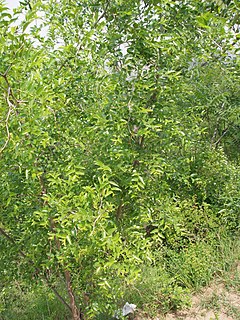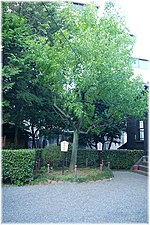Jujube
| Ziziphus zizyphus | |
|---|---|

| |
| Ziziphus zizyphus | |
| Scientific classification | |
| Kingdom: | |
| Division: | |
| Class: | |
| Order: | |
| Family: | |
| Genus: | |
| Species: | Z. zizyphus
|
| Binomial name | |
| Ziziphus zizyphus | |
| Synonyms | |
|
Rhamnus zizyphus | |

Ziziphus zizyphus (from Greek ζίζυφον, zizyfon[1]), commonly called jujube, red date, or Chinese date, is a species of Ziziphus in the buckthorn family Rhamnaceae, used primarily for its fruits. Common names in Arabic are nabq, dum, tsal, sadr, zufzuuf (in Morocco) and sidr, the last of which also means Ziziphus lotus.[2] In Persian it is called anab or annab , a name also used in Lebanon.
Distribution
Its precise natural distribution is uncertain due to extensive cultivation, but is thought to be in southern Asia, between Lebanon, Pakistan, northern India, the Korean peninsula, and southern and central China, and also southeastern Europe though more likely introduced there.[3]
Growth
It is a small deciduous tree or shrub reaching a height of 5–10 m, usually with thorny branches. The leaves are shiny-green, ovate-acute, 2–7-cm wide and 1–3-cm broad, with three conspicuous veins at the base, and a finely toothed margin. The flowers are small, 5-mm wide, with five inconspicuous yellowish-green petals. The fruit is an edible oval drupe 1.5–3-cm deep; when immature it is smooth-green, with the consistency and taste of an apple, maturing brown to purplish-black and eventually wrinkled, looking like a small date. There is a single hard stone similar to an olive stone.[3]
Nomenclature
The species has a curious nomenclatural history, due to a combination of botanical naming regulations, and variations in spelling. It was first described scientifically by Carolus Linnaeus as Rhamnus zizyphus, in Species Plantarum in 1753. Later, in 1768, Philip Miller concluded it was sufficiently distinct from Rhamnus to merit separation into a new genus, in which he named it Ziziphus jujube, using Linnaeus' species name for the genus but with a probably accidental single letter spelling difference, 'i' for 'y'; for the species name he used a different name, as tautonyms (repetition of exactly the same name in the genus and species) are not permitted in botanical naming. However, because of Miller's slightly different spelling, the combination correctly using the earliest species name (from Linnaeus) with the new genus, Ziziphus zizyphus, is not a tautonym, and therefore permitted as a botanical name; this combination was made by Hermann Karsten in 1882.[3][4]
Cultivation and uses
Jujube was domesticated in the Indian subcontinent by 9000 BCE.[5] Over 400 cultivars have been selected.
The tree tolerates a wide range of temperatures and rainfall, though it requires hot summers and sufficient water for acceptable fruiting. Unlike most of the other species in the genus, it tolerates fairly cold winters, surviving temperatures down to about −15°C. This enables the jujube to grow in desert habitats, provided there is access to underground water through the summer. Virtually no temperature seems to be too high in summertime.
Medicinal use
The fruits are used in Chinese and Korean traditional medicine, where they are believed to alleviate stress. [citation needed] The jujube-based Australian drink 1-bil avoids making specific stress-related claims, but does suggest drinking 1-bil "when you feel yourself becoming distressed".[6]
Ziziphin, a compound in the leaves of the jujube, suppresses the ability to perceive sweet taste in humans.[7] The fruit, being mucilaginous, is also very soothing to the throat and decoctions of jujube have often been used in pharmacy to treat sore throats.

Culinary use

The freshly harvested as well as the candied dried fruits are often eaten as a snack, or with tea. They are available in either red or black (called hóng zǎo or hēi zǎo, respectively, in Chinese), the latter being smoked to enhance their flavor.[8] In China and Korea, a sweetened tea syrup containing jujube fruits is available in glass jars,[9] and canned jujube tea or jujube tea in the form of teabags is also available. Although not widely available, jujube juice[10] and jujube vinegar[11] (called 枣醋 or 红枣醋 in Chinese) are also produced; they are used for making pickles (কুলের আচার) in West Bengal and Bangladesh.
In China, a wine made from jujubes, called hong zao jiu (红枣酒) is also produced.[12] Jujubes are sometimes preserved by storing in a jar filled with baijiu (Chinese liquor), which allows them to be kept fresh for a long time, especially through the winter. Such jujubes are called jiu zao (酒枣; literally "spirited jujube"). These fruits, often stoned, are also a significant ingredient in a wide variety of Chinese delicacies. In Korea, jujubes are called daechu (대추) and are used in teas and samgyetang. It is said to be helpful in aiding the common cold.
In Lebanon, the fruit is eaten as snacks or alongside a dessert after a meal.
In Persian cuisine, the dried drupes are known as annab, while in neighboring Azerbaijan it is commonly eaten as a snack, and are known as innab. In Pakistan, the fruit is eaten both fresh and dried, and is known as ber (a generic term for berry).
In Tamil-speaking regions, the fruit is called ilanthai pazham (இலந்தை பழம்). Traditionally, the fruits are dried in the sun and the hard nuts are removed. Then, it is pounded with tamarind, red chillies, salt, and jaggery. Small dishes are made from this dough and again dried in the sun, and are referred to as ilanthai vadai. In some parts of the Indian state of Tamil Nadu, fresh whole ripe fruit is crushed with the above ingredients and dried under the sun to make delicious cakes called ilanthai vadai.[13]
Other uses
The jujube's sweet smell is said to make teenagers fall in love, and as a result, in the Himalaya and Karakoram regions, men take a stem of sweet-smelling jujube flowers with them or put it on their hats to attract women.[citation needed]
In the traditional Chinese wedding ceremony, jujube and walnut were often placed in the newlyweds' bedroom as a sign of fertility.
In Bhutan, the leaves are used as a potpourri to help keep the houses of the inhabitants smelling fresh and clean. It is also said to keep bugs and other insects out of the house and free of infestation. However, this is not true.
In Japan, the natsume has given its name to a style of tea caddy used in the Japanese tea ceremony.
In Korea, the wood is used to make the body of the taepyeongso, a double-reed wind instrument. The wood is also used to make Go bowls.
In Vietnam, the jujube fruit is eaten freshly picked from the tree as a snack. It is also dried and used in desserts, such as sâm bổ lượng, a cold beverage that includes the dried jujube, longan, fresh seaweed, barley, and lotus seeds.
A jujube honey is produced in the middle Atlas Mountains of Morocco.
Pests and diseases
Witch's brooms, prevalent in China and Korea, is the main disease affecting jujubes, though plantings in North America currently are not affected by any pests or diseases.[14]
References
- ^ ζίζυφον, Henry George Liddell, Robert Scott, A Greek-English Lexicon, on Perseus Digital Library
- ^ "The ethnobotany of Christ's Thorn Jujube (Ziziphus spina-christi) in Israel". Journal of Ethnobiology and Ethnomedicine. 1 (8). 2005. doi:10.1186/1746-4269-1-8. Retrieved 5 June 2010.
{{cite journal}}: Unknown parameter|authors=ignored (help)CS1 maint: unflagged free DOI (link) - ^ a b c Rushforth, K. (1999). Trees of Britain and Europe. Collins ISBN 0-00-220013-9.
- ^ Clarke, D. L. (1988). W. J. Bean Trees and Shrubs Hardy in the British Isles, Supplement. John Murray ISBN 0-7195-4443-2.
- ^ Gupta, Anil K. in Origin of agriculture and domestication of plants and animals linked to early Holocene climate amelioration, Current Science, Vol. 87, No. 1, 10 July 2004 59. Indian Academy of Sciences.
- ^ Information on 1-mil from the company's website[dead link]
- ^ Kurihara, Y. 1992. Characteristics of antisweet substances, sweet proteins, and sweetness-inducing proteins. Crit. Rev. Food Sci. Nutr. 32:231-252.
- ^ "Rare Fruit: Jujubes". Seasonalchef.com. Retrieved 1 August 2010.
- ^ [1][dead link]
- ^ [2][dead link]
- ^ Picture of a bottle
- ^ [3][dead link]
- ^ "Kamala's Corner: Indian Jujube - Elanthai Pazham". Kamalascorner.com. Retrieved 1 August 2010.
- ^ Fruit Facts: Jujube
Further reading
- Fruits of Warm Climates. Julia. F. Morton, Miami, FL: 1987.
External links
